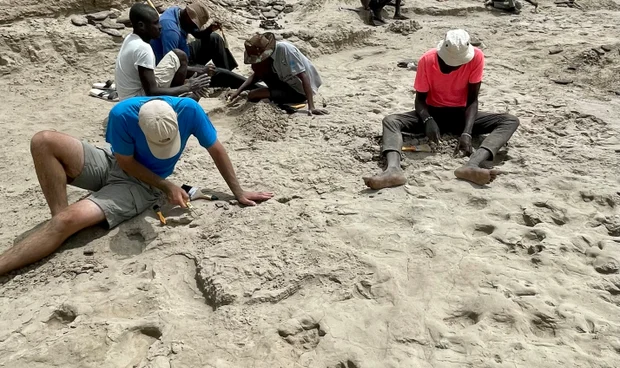Kenyan footprints “illustrate the coexistence of distant relatives of modern humans.”

News Mania Desk / Piyal Chatterjee / 29th November 2024
A big-toothed relative of prehistoric humans walked swiftly alongside a lake in Kenya approximately 1.5 million years ago, leaving tracks on the muddy ground. However, they weren’t the only distant relative present; Homo erectus, the earliest human, was also on the scene. According to researchers, an examination of fossilized footprints found in the Turkana Basin in northern Kenya indicates that the impressions were left by two distinct species of the human family tree that were present in the same location within a few hours or days of one another.
Skeletal fossils have previously shown that these species might have coexisted, but the extent of the deposits they are discovered in and the timespans they can be dated to make it impossible to pinpoint interactions. “This is the first direct snapshot of the two species together on the same immediate landscape,” said Dr Kevin Hatala, the first author of the research from Chatham University in the US.
In a paper published in the journal Science, Hatala and associates described how they found a continuous series of footprints in the deposits left by a single human person, in addition to fossilized animal and bird traces. They saw that the trackway’s stride length indicated that the person was moving at a moderately quick pace. However, in terms of foot structure and walking contact patterns, the imprints were different from those seen in contemporary humans.
Rather, they claimed that the impressions seemed to match the footprints predicted by Paranthropus boisei, a species that is not a human ancestor but rather a side branch of our family tree and is also referred to as Nutcracker Man because of its large teeth. Hatala stated that certain features of their big toe anatomy, in particular, appear to be in line with the patterns found in the footprints. Three distinct prints that were in opposite orientations to this trackway were also discovered nearby by the crew.
These, the researchers said, did appear similar to those observed in modern humans, suggesting they were made by Homo erectus, an ancestor of our own species that lived in the region at the time.
“I would expect the two species would have been aware of each other’s existence on that landscape, and they probably would have recognised each other as being ‘different’,” said Hatala. “This raises lots of fascinating questions about how they would have interacted, and we don’t have all of those answers yet.”
The researchers also noted that upon examining further fossilized hominin footprints discovered in east Turkana at a comparable time period, they discovered that some of them also had indications of having been created by two distinct hominid species. Prof. Chris Stringer, who was not involved in the study but is the head of human origins at the Natural History Museum in London, called the research “fascinating,” adding that although it was impossible to know for sure which species left the tracks, the team had been cautious in determining the likelihood.
“It’s wonderful that these early human relatives can now be placed directly in a lakeside landscape, walking and wading on wet surfaces, and probably feeding on the plant and animal resources there,” he said. “[The authors] suggest that the two species with their different diets were probably not competing strongly at this time, hence their close and tolerant proximity in time and space.”






